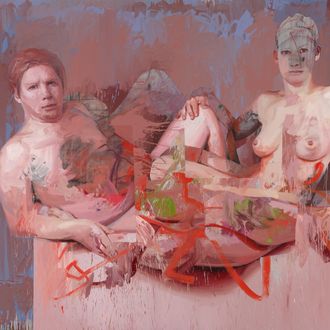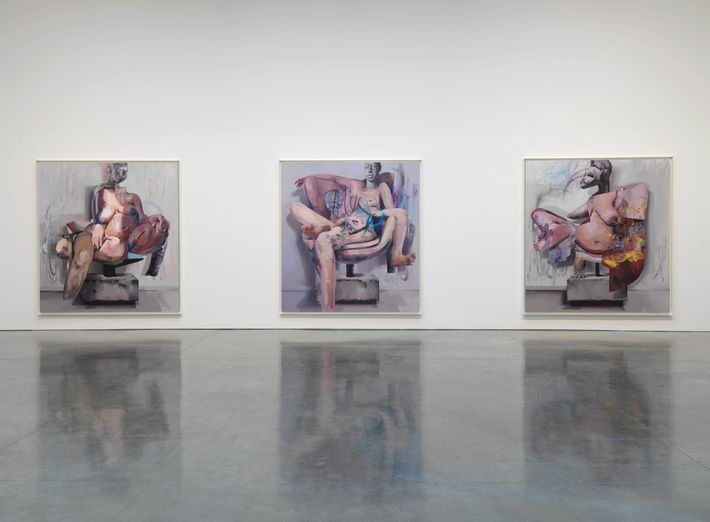
Jenny SavilleÔÇÖs 11-year-old son sees a great deal of art, and gives each exhibition a score, one to ten. His motherÔÇÖs current show of large, literate, classically inspired paintings at Gagosian Gallery, ÔÇ£Ancestors,ÔÇØ scored eight out of ten stars, which seems reasonable, even if his methodology might seem a bit obscure, and who knows what she could have done to give them a perfect ten. Also, as he points out after his mother asks, itÔÇÖs a better score than he gave Charles RayÔÇÖs stainless-steel sculptures, including one of a mountain lion killing a dog, over at Matthew Marks, which earns only six.
Saville became famous early, when the advertising man and art collector Charles Saatchi decided to invent, and promote, a set of Young British Artists (a.k.a. the YBAs) in the 1990s. She was among them, along with Damien Hirst, Gary Hume, and others. Most startlingly at the time, she painted plus-size humans, inspired by the midwestern physical abundance she encountered during a postgraduate stint at the University of Cincinnati. SheÔÇÖd just not seen anything quite like it back home in England.
Today, sheÔÇÖs a pleasantly grown-up and low-key 48, with two kids, two studios, paint flecks on her glasses, no time or personal inclination to bother with social media, and, at least on this trip to New York with her son, a practical air of just getting things done. She tells me, in passing, as we walk the show (the guard doesnÔÇÖt recognize her and keeps ordering us to back away from the work), up through July 20, that when she got to Gagosian, ÔÇ£there were no other female artists represented by the gallery. So the art world has changed enormously.ÔÇØ
Saville paints actual people; possibly out of convenience, sheÔÇÖll deploy her son and daughter as models, or at least parts of them, versions of them: thatÔÇÖs his leg there, her body at rest. While motherhood has become part of what her art is about over the last decade, itÔÇÖs a decision that, to her mind, ÔÇ£was kind of risky,ÔÇØ she tells me. ÔÇ£It is all right to be a female painter but to also be a mother and a female painter is something you donÔÇÖt really want to advertise. Or thatÔÇÖs how it was seen.ÔÇØ
But sheÔÇÖs is a painter of flesh, so why not the flesh of her flesh? ÔÇ£I realized I spent my life painting flesh, and I could produce flesh in my body,ÔÇØ she says. ÔÇ£That was profound: to paint flesh at the same moment as I was building it in my body. That became a real push of my creativity. People will say, ÔÇÿoh female creativity goes down when you have children.ÔÇÖ But I felt a huge impulse to create work.ÔÇØ (Fortunately, Saville has been successful long enough that she can afford help.)

She mentions the Venus of Hohle Fels, a tiny, 40,000-year-old figurine carved out of mammoth ivory, which was just discovered in 2008. ÔÇ£ItÔÇÖs aggressive and big-breasted,ÔÇØ she says (no head, no legs, just the parts which say: fertility). ÔÇ£We donÔÇÖt know who made it,ÔÇØ men or women, she says. The Venus partly inspired some of the works in ÔÇ£Ancestors,ÔÇØ which depict fragmentary figures, some painted from digital photographs of actual people combined with elements from ancient statuary. ÔÇ£You can have multiple limbs, multiple ways of being, lots of lines. I definitely donÔÇÖt want it to have a sort of postmodern collage element,ÔÇØ she says, worrying a bit. ÔÇ£So it has got to merge and have a wholeness.ÔÇØ
It takes a while, she says, to get to that sense of wholeness. ÔÇ£It is not something you can just do in a few days or a couple of hours per day. It is hours and hours, weeks and weeks, and months and months building it up.ÔÇØ One of her studios is for painting and one for drawing, and she bikes back and forth between the two, toggling projects and sets of intentions and inspirations. Sometimes she just leaves things to sit fallow for months, ÔÇ£until they evolve into something else.ÔÇØ
This show is, in part, a response to the #MeToo movement. ÔÇ£A feeling of empowering women,ÔÇØ she says, pointing around the room. ÔÇ£These women are real and meaty. I think that [#MeToo] has definitely helped me in that body of work and the development of that work.ÔÇØ
But she also recognizes how things have changed in the 25 years since she had a rather fortunate and fast start to her career. ÔÇ£The art world is a different place from when I started out. There were no female tutors at my college. You didnÔÇÖt see womenÔÇÖs work in museums that much. Maybe at the lower curatorial level, but now we have female directors,ÔÇØ she says. ÔÇ£The difference is that the prices of work for women have not broken the same sort of levels of men. That is something that is slowly changing,ÔÇØ thanks in part, she thinks, to the rise of the art adviser, many of whom are women. ÔÇ£A female art adviser may guide [a collector] towards work made by women that they might have just avoided. There are a lot of really clever, smart female art advisers who are helping these collectors, and that is developing their taste in a broader sense.ÔÇØ

Other things have not changed quite as much. I ask her about the male nudity in some of her work: Is there still more of a market for the female nude? ÔÇ£Penises in art are still a problem, for sure,ÔÇØ she says. ÔÇ£Collectors find it more difficult.ÔÇØ
Saville always wanted to be a painter of serious paintings, to carry forward that grand Western tradition, and was so shocked when she realized that had always been a mostly male profession, she almost quit painting altogether. ÔÇ£When I got to art school I just na├»vely didnÔÇÖt realize that there were not great female artists ÔÇö in the past I just didnÔÇÖt know it. I had an epiphany in the art school library and said, ÔÇÿWell, where are the girls?ÔÇÖÔÇØ she says.
ÔÇ£So I gave up painting for a little bit,ÔÇØ Saville recalls. ÔÇ£I started taking photographs and doing casts and I literally felt homesick in my body. I just couldnÔÇÖt manage. It was like my language had gone. I couldnÔÇÖt manipulate the world. I was wearing somebody elseÔÇÖs coat, basically.ÔÇØ
Luckily, around that time, she came to America and was exposed to ideas about patriarchy in the womenÔÇÖs studies program at the University of Cincinnati. She learned about then-new French feminism, including Luce Irigaray and her theories of ├®criture f├®minine ÔÇö that there is a distinctly female form of writing. And out of that, one could argue, Saville created a female painting. ÔÇ£It gave me a language,ÔÇØ she says. ÔÇ£My eye was in old oil paintings, and then I had this feminist theory, and I had to combine the two. So then I had to go back to painting and I thought, okay, the only thing I can do is try to navigate this thing, the tension between figuration and abstraction. Between traditional art history and more feminist theory. I went from thinking it [the combination] was a weakness to realizing it was a strength. I had no choice. It was my language.ÔÇØ
Of course, the other lucky thing she found in Cincinnati were the fleshy midwestern American women, unashamed of their size, the depiction of which made her famous. But, she cautions, while ÔÇ£it was seen that I painted fat women as some sort of feminist strategy, it wasnÔÇÖt that at all. It wasnÔÇÖt ÔÇÿfat is a feminist issue.ÔÇÖ I just had people around me who were big, and I like the story of being that big. The narrative of being that big is all in the body. I didnÔÇÖt have to create anything other than that body.ÔÇØ
ItÔÇÖs a bit hard to imagine a man deeming it interesting enough to paint them, though. Thirty years after she was shocked to find that, as a woman interested in being a part of the grand traditions of art history, she didnÔÇÖt really have many ancestors, the Gagosian show is part of her imagining her own mythic ancestors, a genealogy for a canon that women are no longer so lonely in.
ÔÇ£Jenny Saville: AncestorsÔÇØ is open through July 20 at Gagosian, 522 W. 21st St.


